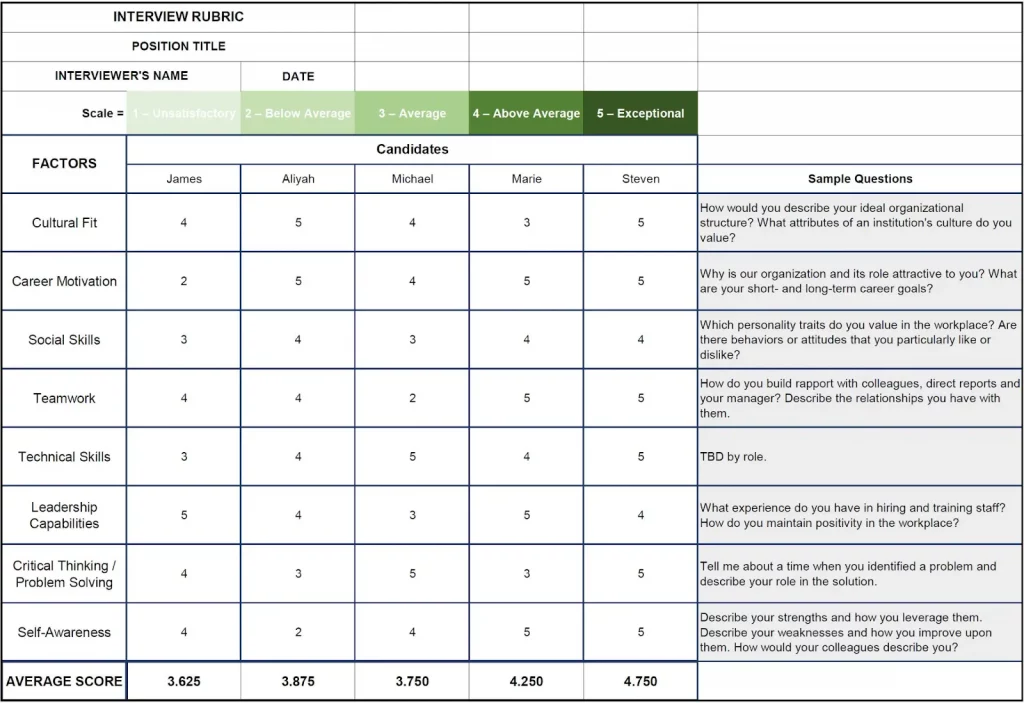Hiring an employee can be a daunting task. There are many things to consider, from the job requirements to the company culture. One tool that can help make the process easier is a hiring rubric.
Creating a hiring rubric is an essential part of the hiring process. It helps to ensure that you are looking for the right candidates, and it also makes the process more efficient and fair. In this blog post, we will discuss what a hiring rubric is and how to create one.
What is a hiring rubric?
A hiring rubric is a scoring tool that defines the expectations used to evaluate each candidate. By using a hiring rubric, also known as a hiring matrix or hiring scorecard, each person in a group discussion can participate equally in assessing candidates.

A rubric is useful because it helps to determine who will be interviewed, invited to re-interview, and eventually offered a job. As a result, search committees or hiring teams may use an applicant screening rubric in addition to an interview rubric.
Rubric applications in hiring
Regarding hiring, rubrics can be a valuable tool in assessing candidates. They can help to standardize the evaluation process, by making it fair and consistent.
Additionally, they can help identify candidates’ strengths and weaknesses, allowing for better decision-making. When designing a rubric for hiring, it is important to consider the specific criteria used to assess candidates.

Some common factors that may be considered include:
- Education and experience
- Skills and abilities
- Competencies
- Attitude and interpersonal skills
- Work ethic
- Motivation
Each of these factors can be further broken down into more specific criteria. For example, when assessing a candidate’s education and experience, you may consider their degree level, the relevance of their work experience, and the quality of their references.
As you develop your rubric, remember that it should be tailored to the specific job you are hiring for. This will help to ensure that only the most qualified candidates are considered.
Hiring rubrics in different interview formats
Hiring rubrics take on different forms in different interview settings. In blind hiring, the interviewer does not see the candidate’s resume or other identifying information. This type of interview is often used to assess a candidate’s skills rather than qualifications.

Here are the formats that you can consider.
Job application screening rubric
A hiring rubric is a tool that can be used by employers to help them evaluate job applicants. It is a scoring system that allows employers to rate applicants on a variety of factors, such as their qualifications, work experience, and personal characteristics. The hiring rubric can be used in conjunction with other assessment tools, such as interviews and reference checks.
Creating a application screening rubric for the company can be beneficial for both employers and job seekers. For employers, an application rubric makes sure that company standards are upheld and that the hiring manager only spends time interviewing candidates with a high chance of successfully completing the role. It can also help to create a more equitable and fair hiring process. These questions will be slightly more general than the interview rubric, focusing on the minimum qualifications of the role.
Phone interview rubric
When it comes to phone interviews, the phone interview rubric is an essential tool. It keeps the interviewer focused on the specific needs of the role. This interview allows employers to ask questions and get to know a job applicant prior to the more time-intensive in-person meeting. While this can be a great way to save time and money, it can also be tricky to get a true sense of a candidate over the phone. The structured phone interview rubric ensures that each applicant is evaluated from the same set of criteria.
Personal interview rubric
Personal interviews can be an essential part of the hiring process. This is your chance to meet with potential employees face-to-face and get to know them personally. In certain situations a video interview will have to do, however.

Panel interview
If you’re looking for a way to add an extra level of objectivity to your group interviews, consider using an evaluation board. By bringing in multiple viewpoints, you can insure that all candidates are getting a fair shake and that the person who ultimately gets the job is the most suitable candidate.
Hiring rubric sample template
Below is a sample hiring rubric you can use as a guide when creating your own. This rubric can be customized to fit the specific needs of your company, department and role.
|
Qualifications |
Work experience |
Personal Characteristics |
Communication skills |
|
Does the candidate have the necessary qualifications for the job? |
Does the candidate have relevant work experience for the job? |
Is the candidate friendly and personable? |
Is the candidate’s communication clear and concise? |
|
Are the candidate’s qualifications relevant to the job? |
Is the candidate’s work experience verified? |
Is the candidate respectful and professional? |
Does the candidate listen well and ask questions when appropriate? |
|
Are the candidate’s qualifications verified? |
Does the candidate’s work experience demonstrate their ability to do the job? |
Does the candidate have a positive attitude? |
Is the candidate able to articulate their thoughts and ideas effectively? |
Final Interview Scoring
The final interview is usually the last step in the hiring process. During the final interview, recruiters need to learn about the candidate’s experience, goals, and reasons for being a good fit for the job.
Each interviewer’s score will be pulled together post interview to create an overall impression of the candidate.
Here is what the final evaluation could look like when deciding between multiple candidates. The value in having the interviewer’s feedback recorded is that if you have another position open up you can review the candidates that applied in the past, showed to be a strong fit and more quickly fill the role. As you can see, by applying a score to each trait, you quickly identify your top candidate.

Conclusion
Now that you understand what a hiring rubric is and how to create one, you can start using this valuable tool in your organization. By thoughtfully considering each candidate against a set of predetermined criteria, you ensure the best hiring decisions for your company.
The final interview is usually the last step in the hiring process. During the final interview, recruiters need to learn about the candidate’s experience, goals, and reasons for being a good fit for the job.
The rubric can be used to score responses to questions and employees’ overall impressions during the interview.
References
- Sian Brannon, Julie Leuzinger. (2014). Keeping Human Resources happy: improving hiring processes through the use of rubrics. Denton: Pixey Mosley. Retrieved from https://diversity.med.wustl.edu/wp-content/uploads/2018/05/Keeping-Human-Resources-Happy.pdf
- Smartsheet. (2018). JOB INTERVIEW RUBRIC TEMPLATE. Smartsheet. Retrieved from https://www.smartsheet.com/sites/default/files/IC-Job-Interview-Rubric-9410_PDF.pdf

